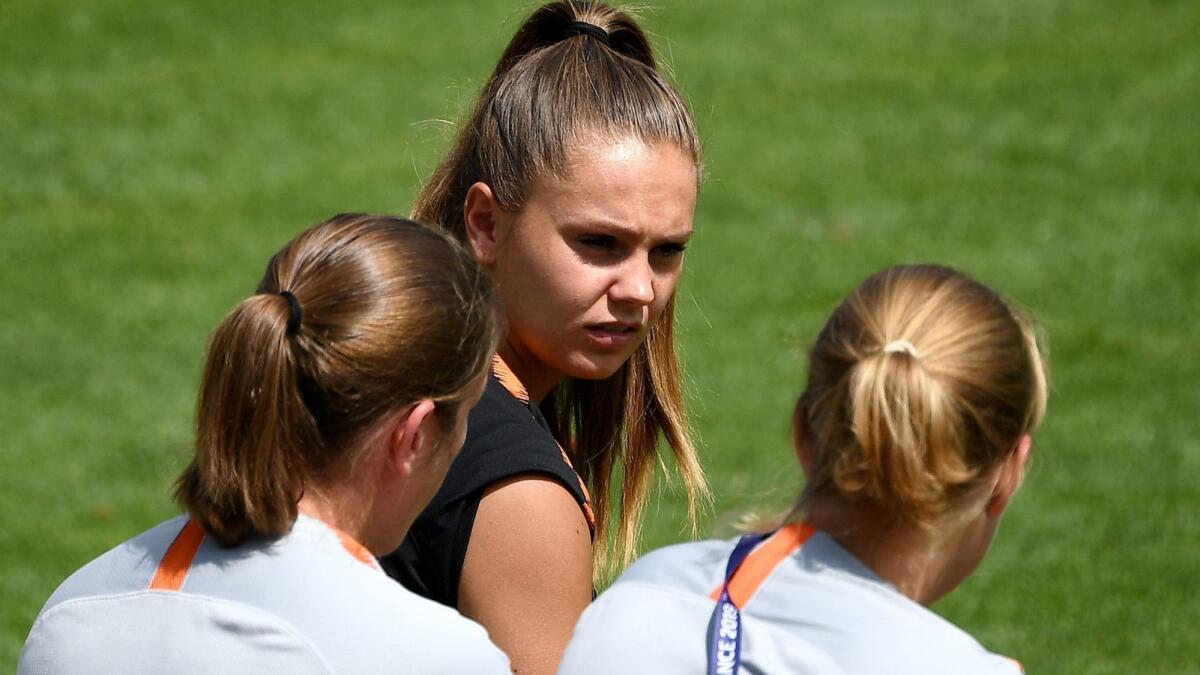Netherlands looks to add Women’s World Cup title to European championship

- Share via
Reporting from lyon, france — A little more than a decade ago, women’s soccer in the Netherlands received so little respect, the girl who would go on to become the country’s best player had to join a boys’ team because that’s all there was.
“I had a totally different way than the girls in the U.S.,” Lieke Martens said. “I had talent. I wanted to do something with it. [But] it was ‘maybe it’s better to play hockey or tennis or another sport.’”
How times have changed.
On Sunday the Dutch, the reigning European champions, will play those girls from the U.S. in their first Women’s World Cup final. And the people back home have been fully invested in the journey.
Eighty percent of the people watching television at the time were tuned to the team’s quarterfinal win over Italy, and the team’s last four competitive matches in the Netherlands — all World Cup qualifiers — averaged more than 24,000 attendees a game, more than three times what the U.S. averaged in its five World Cup qualifiers matches at home.
Tens of thousands more fans have made the short trip from Holland to France for this tournament.
Not bad for a country where women’s soccer was repeatedly banned, only to be accepted when UEFA made a women’s team mandatory for membership in the confederation. But it never said the team had to be taken seriously.
For Dutch coach Sarina Wiegman, everything changed in 2007. Women’s soccer in the Netherlands was still amateur and the country’s best players were leaving to play in Germany and elsewhere when the national federation organized a professional league and clubs began to invest in those teams.
The league lasted just five years before briefly giving way to a combined Belgian-Dutch league in 2012. But the way the country viewed and funded women’s soccer had fundamentally changed.
“The potential has been in the Netherlands for a longer period of time. But the facilities weren’t there,” said Wiegman, who played college soccer at North Carolina alongside U.S. national team legends Mia Hamm and Kristine Lilly. “Since 2007 players got better facilities and could train more. The players developed so much. And then when you are at big tournaments like European Championships and World Cups, they develop even more.”
The country’s first major tournament, the 2009 European Championship, came two years later and the Dutch, with 20 of their 22 players coming off teams in the new domestic league, made it to the semifinals. Three of the players from that roster are still on the national team.
“It’s the whole development in the Netherlands. And also the individuals that made bigger steps,” Wiegman said. “Now they’ve been in a couple of tournaments, so they are very experienced now too. They believe they can perform.
“And belief is one of the things that make things happen.”
Belief and talent. Because that modest investment in a professional league a dozen years ago has turned the Netherlands into one of the most prolific producers of women’s soccer players in Europe.
Goalkeeper Sari van Veenendaal, midfielders Danielle van de Donk and Jill Roord and forward Vivianne Miedema, the national team’s all-time leader score, all started in the Dutch league and now play for Arsenal in the Women’s Super League. Midfielders Jackie Groenen and Inessa Kaagman and defender Danique Kerkdijk followed a similar path from the Dutch league to England.
Sign up for our weekly soccer newsletter »
Forward Lineth Beerensteyn and defender Desiree van Lunteren went from Holland to the German Bundesliga, while defender Stefanie van der Gragt and Martens are playing in Spain for Barcelona. Martens made a stop in Sweden along the way, picking up the women’s world player of the year award in 2017.
Only five of the players on the World Cup roster still play in Holland. But that, too, is progress, said Wiegman, because playing for the biggest clubs in the biggest leagues brings the biggest challenges — and the biggest improvements.
Yet the Dutch are still feeling their way. Despite the national team’s quick climb, there’s been some backsliding along the way.
After its auspicious debut in the 2009 Euros, for example, the Netherlands failed to win a game in the same tournament four years later. In its first Women’s World Cup in 2015, it made it to the round of 16; three years later the Dutch had to survive a complicated series of four playoff games just to get back to the tournament this summer.
Now they’re in the final.
“We went through different stages of development as a team,” said Groenen, who scored the only goal in Wednesday’s semifinal victory over Sweden. “It was hard for us in the beginning. But this team, all of us, we work so hard to deliver and to do well. It’s so nice to be in the final.”
And this could just be the start. Martens, the girl who once had to play with boys, said she had no female soccer stars to emulate growing up. Now she’s inspiring a generation to follow in her footsteps.
“It’s cool now that I can be a role model,” she said. “Even parents, they are more excited that their daughters are going to play football. They can see that women’s football is cool.”
kevin.baxter@latimes.com | Twitter: @kbaxter11







